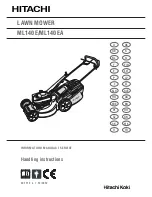
SAFE OPERATION
-
2
ENGLISH
5. Always use the seat belt when the ROPS is upright. Do
not use the seat belt if the ROPS is down or if there is
no ROPS. Check the seat belt regularly and replace if
frayed or damaged. Be certain that the seat belt can be
released quickly in the event of an emergency.
6. Do not operate the machine or any attachments while
under the influence of alcohol, medication, controlled
substances or when fatigued.
7. Do not wear loose, torn, or bulky clothing around
machine. The clothing may catch on moving parts or
controls, leading to the risk of accident. Wear and use
any additional safety items such as hard hat, safety
boots or shoes, eye and hearing protection, gloves,
etc., as appropriate or required.
8. Do not wear radio or music headphones while
operating the machine.
Safe operation requires your full attention.
9. Carefully check the vicinity before operating machine
or any implement attached to it. Clear the work area of
objects (wires, rocks, etc.) that might be picked up and
thrown. Check for overhead clearance which may
interfere with a grass catcher.
10. Check brakes and other mechanical parts for correct
adjustment and wear. Replace worn or damaged parts
promptly. Check the tightness of all nuts and bolts
regularly. (For further details, see "PERIODIC
SERVICE" and "ADJUSTMENT" section.)
11. Keep all shields and guards in place. Replace any that
are damaged or missing. Do not operate unless they
are functioning properly.
12. Before allowing other people to use your machine,
explain how to operate and have them read this
manual before operation.
13. Do not allow any bystanders around or near machine
during operation.
14. Do not allow passengers, children or non-qualified
operators on the machine at any time. The operator
must remain in the machine seat throughout
operation.
15. In addition to the design and configuration of
equipment, hazard control and accident prevention
are dependent upon the awareness, concern, and
prudence of personnel involved in the operation,
transport, maintenance of facilities.
16. Evaluate the terrain to determine what accessories
and attachments are needed to properly and safely
perform the job. Keep the machine and attachments in
good operating condition and keep safety devices in
place and in proper working condition. Do not operate
unless they are functioning properly.
17. Do not modify the machine. Unauthorized modification
may affect the function of the machine, which may
result in personal injury.
18. Use only implements recommended by KUBOTA. Use
proper ballast to front or rear of machine to reduce the
risk of upsets. Follow the "SAFE OPERATION"
procedures, specified in the manuals with equipment.
19.Keep your machine clean. Accumulations of dirt,
grease, and trash can contribute to fires and lead to
personal injury.
20.The exhaust gas from the muffler is very hot. To
prevent fire, do not expose dry grass, mowed grass, oil
and any other combustible materials to exhaust gas.
Use a spark arrester where required. Also keep the
engine and muffler clean all the time.
C
Starting
1. Always sit in the operator's seat when starting engine
or operating levers or controls.
2. Before starting the engine make sure that the motion
control levers are in neutral lock, the parking brake is
applied, and Power Take Off (PTO) is disengaged
(OFF).
3. Do not start engine by shorting across starter
terminals. The machine may start in gear and move if
normal starting circuitry is bypassed.
4. Do not operate or idle engine in a non-ventilated area.
Carbon monoxide gas is colorless, odorless, and
deadly.
C
Working
1. Do not turn sharply when driving at high speed.
2. To avoid tip over, slow down when turning on uneven
terrain or before stopping.
3. Do not operate near ditches, holes, embankments, or
other terrain, which may collapse under the machine
weight. The risk of machine tip over increases when
the ground is loose or wet.
4. Park the machine on a firm and level surface.
5. Watch where you are going at all times. Watch for and
avoid obstacles. Be alert at curbs, shrubs, near trees,
and other obstructions and hidden hazards. Obstacles
can damage machine (fuel hoses, wire harness etc.).
6. Know what is behind you before backing up. Look to
the rear before and when backing. Do not mow while
in reverse unless absolutely necessary and make sure
the area immediately behind you is clear of
obstructions or holes and small children. Use extra
caution when machine is equipped with Grass
Catcher. Your view to the rear is restricted.
7. When working in groups, always let others know what
you are doing ahead of time.
8. Do not drive machine on streets or highways. Watch
for traffic when you cross roads or operate near roads.
9. Be aware of the mower discharge direction and do not
point it at anyone.
Never operate with the discharge deflector raised,
removed or altered, unless using a grass catcher.
2. OPERATING










































